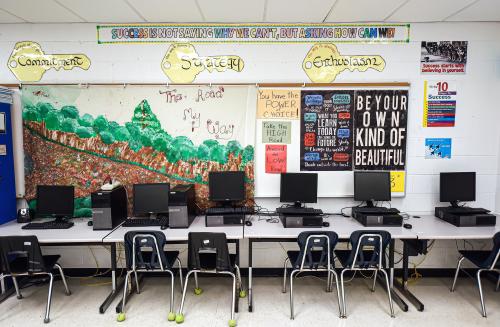From the continued response to pandemic disruptions to culture war issues that have surfaced in schools, 2022 was an eventful year for U.S. schools and education policy. That looks to be true for 2023 as well.
Below, experts from the Brown Center on Education Policy identify the education stories that they’ll be following in 2023, providing analysis on how these issues could shape the learning landscape for the next 12 months—and possibly well into the future.
 DAPHNA BASSOK (@DaphnaBassok)
DAPHNA BASSOK (@DaphnaBassok)
Nonresident Senior Fellow:
In 2023, I’ll be watching innovative state and local efforts to better fund childcare and better support early educators. The pandemic highlighted the essential role childcare plays in the lives of children, families, and the U.S. economy. It also made clear that without greater public support, childcare providers cannot pay teachers adequately and cannot offer families essential supports. The high teacher turnover rates common in early childhood settings compromise quality, and during the pandemic, they also compromised access to care. In Virginia, two thirds of publicly funded childcare centers shut down classrooms or turned families away because they could not recruit and retain teachers.
Pandemic relief dollars provided an essential lifeline to childcare. However, as these funds run out, states are now facing a stark funding cliff which will exacerbate staffing challenges considerably. New Mexico recently passed a ballot measure to establish a permanent funding source in the state constitution, making it the first state in the country to do so. Washington, D.C. approved funding to work towards childcare compensation that approaches the pay of other D.C. teachers. Virginia recently changed their approach to funding subsidized childcare to better account for the true cost of childcare, including better compensation. I’m hopeful other states will follow with big investments and that as the federal funding cliff approaches, we’ll finally see large federal investments in childcare.
 MICHAEL HANSEN (@DrMikeHansen)
MICHAEL HANSEN (@DrMikeHansen)
Senior Fellow:
Heading into 2023, I am monitoring the status of the K-12 teacher workforce and reports of teacher shortages. The COVID-19 pandemic has stretched many schools’ human resources in recent years, with teachers reporting heightened burnout and intentions to leave. Combined with preexisting trends of a weakening teacher pipeline and anemic application pools for certain positions and settings, many worried that we may tip into a full-scale crisis.
I am pleased to report that recent evidence increasingly points in the direction of the teacher workforce weathering the storm, even if the rains haven’t yet fully subsided. For example, district surveys from the spring of 2022 pointed to expected turnover in the current school year (2022-2023) likely being slightly less taxing than last year (2021-2022). New evidence from Washington State shows even the elevated turnover experienced in 2021-2022 was within the range of historical teacher turnover spanning nearly four decades. Finally, another new study from Illinois points to increased staffing levels, particularly among non-teacher staff, as the primary driver of elevated vacancies in schools, even as student enrollments are falling. These reports and other data points give me confidence that we’ll make it through.
Don’t celebrate just yet, though. We still have work to do shoring up localized shortages in spots that have persistent hiring problems and doing what we can to make the teaching profession more attractive, especially among people of color.
 DOUGLAS N. HARRIS (@DouglasHarris99)
DOUGLAS N. HARRIS (@DouglasHarris99)
Nonresident Senior Fellow:
The first thing I’m looking for in 2023 is a sign that educators, families, and students have responded to COVID-19 by making permanent and systemic improvements in schooling. As I’ve written before, COVID-19 forced everyone into novel practices. Did they develop new habits that are having lasting positive influence, such as using new kinds of devices and software? Or did remote learning create bad habits (e.g., distraction from smart phones) that are making it even more difficult for students to rebound? Anecdotally, I think the answer is “both,” but I hope some enterprising researchers and journalists are looking into this.
There’s also something I’m not looking for: I don’t expect a noticeable student rebound from COVID-19 learning loss anytime soon. The early evidence doesn’t provide much reason for hope. I think this is because: (a) if educators knew how to get students to catch up from a massive upheaval like this, they would have already been doing this for struggling students before COVID-19; (b) hiring more educators or bringing in new programs with the ESSER funds has proven difficult because of the tight labor market and temporary nature of the funds; and (c) the take-up rate on voluntary, after-school learning activities has been low.
I’m not exactly optimistic that we’ll “solve” this quickly, but hopefully there’s at least a silver lining in the form of better teaching that will help address the problem gradually, over the long run.
 KATHARINE MEYER (@KatharineMeyer)
KATHARINE MEYER (@KatharineMeyer)
Fellow:
In 2023, my eyes are on the Supreme Court for two consequential higher education decisions. First will be an expedited hearing on the Biden administration’s proposed student loan forgiveness program. The administration accepted 26 million applications for debt relief this fall; however, forgiveness is on hold until the Supreme Court hears oral arguments in February about the legality of the program. For now, the administration has extended the pause on loan repayment. But regardless of the Court’s ruling, restarting payments on remaining balances after a three-year pause will be a significant shift in individuals’ budgets. It is incumbent on the Department of Education to provide borrowers with clear, advance communication about repayment options and resources to avoid default.
Second, the Court heard arguments in October 2022 about the consideration of race in college admissions in two separate cases. I anticipate the Court will rule in favor of the plaintiff in both cases, effectively ending the use of affirmative action. This raises the question of how colleges will shift their recruitment and admissions processes to advance their goals of a diverse community of scholars. Colleges will need to examine what other admissions practices, such as legacy admissions or the review of test scores, they may need to adjust to achieve their mission.
 RACHEL PERERA (@RachelMarisa)
RACHEL PERERA (@RachelMarisa)
Fellow:
In 2023, I will be following two issues in K-12 education policy that have important implications for equity.
First, the Biden administration has signaled that new guidance on how public schools can avoid racial discrimination in school discipline may be forthcoming. Any new guidance is expected to mirror guidelines published in 2014 by the Obama administration (and rescinded by the Trump administration in 2018). The Obama-era guidelines relied on a broader definition of racial discrimination (“disparate impact”) than had been used by prior Republican administrations (“disparate treatment”). This is notable because a “disparate impact” theory of discrimination is better aligned with contemporary understandings of how racial discrimination shapes school outcomes.
I will also be following how school districts spend their remaining COVID-19 relief aid and the implementation of COVID-19 recovery interventions in schools. Emerging research and journalistic reports indicate that school districts are facing significant challenges implementing evidence-based interventions to support students recovering from the varied harms of the pandemic. Other work suggests that the scale of COVID-19 recovery funding provided to schools may be insufficient to meet the current needs of U.S. schools and students. To ensure that students, families, and educators get the support they need, it is critical that we continue to track how COVID-19 recovery in schools is faring.
 JON VALANT (@JonValant)
JON VALANT (@JonValant)
Senior Fellow and Director:
In 2023, I’ll be watching what happens with Republicans’ push for “parents’ rights” in schools. Several states have enacted so-called parents’ rights legislation already, with several others—including Texas, Missouri, and Kansas—poised to consider bills (or constitutional amendments) as the new legislative sessions begin. Even the new GOP House majority might pursue a Parents’ Bill of Rights despite decades-long skepticism from Republicans about federal action in K-12 education. With Democrats in control of the Senate and White House, that federal effort won’t go anywhere legislatively, but it could become a model for Republican-led state governments.
That’s important because the details of these bills matter and have varied quite a bit. (FutureEd has a helpful policy tracker.) Some bills explicitly target teaching about race, gender, and/or sexuality—despite the potential harms to vulnerable students—while others read more like bureaucratic sets of reporting requirements. Some call for major reforms to school choice policies while others sidestep those issues entirely.
Democrats may have something to say about parent supports, too, with continued interest in cutting childcare costs and reinstating an expanded child tax credit that slashed the child poverty rate. But even if it’s possible, with enough squinting, to see hope for bipartisan legislation, it certainly doesn’t feel like 2023 will be a year for bipartisanship in education.
 KENNETH K. WONG
KENNETH K. WONG
Nonresident Senior Fellow:
Results of the local, state, and national elections in 2022 have shifted the landscape of education governance in 2023. Institutional tension is likely to intensify requiring extra efforts by elected officials and stakeholders to resolve their policy differences. At the national level, Republican control in the House will likely slow down, and in some cases, reverse President Biden’s education equity agenda. Congressional oversight will intensify over functions of the U.S. Department of Education and in civil rights enforcement conducted by the U.S. Department of Justice. Challenges against the Biden administration’s policies will also come from states where Republican governors and state attorneys have received strong electoral support. These state leaders will launch legal challenges and legislative actions to resist Biden’s executive initiatives. Finally, at the local level, school board elections have become a contested terrain. While Moms for Liberty, a parental rights group, reported victory for about half of their endorsed board candidates, the National Education Association claimed electoral success for about 70% of their endorsed candidates. A critical issue is whether and how divided governance at all levels will affect schooling opportunity, accountability, and quality for all students in 2023.












Commentary
What Brown Center scholars will be watching in education policy and politics in 2023
January 10, 2023